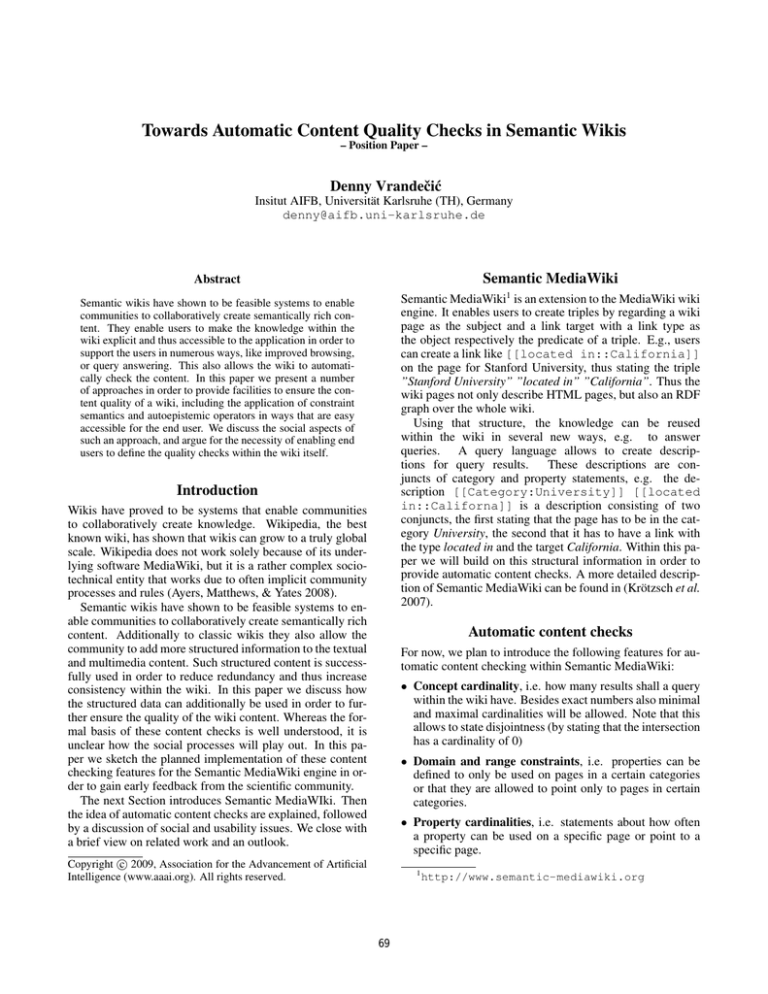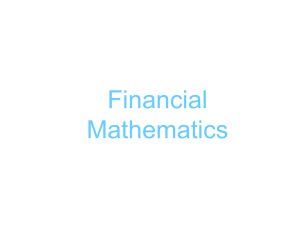
Towards Automatic Content Quality Checks in Semantic Wikis
– Position Paper –
Denny Vrandečić
Insitut AIFB, Universität Karlsruhe (TH), Germany
denny@aifb.uni-karlsruhe.de
Semantic MediaWiki
Abstract
Semantic MediaWiki1 is an extension to the MediaWiki wiki
engine. It enables users to create triples by regarding a wiki
page as the subject and a link target with a link type as
the object respectively the predicate of a triple. E.g., users
can create a link like [[located in::California]]
on the page for Stanford University, thus stating the triple
”Stanford University” ”located in” ”California”. Thus the
wiki pages not only describe HTML pages, but also an RDF
graph over the whole wiki.
Using that structure, the knowledge can be reused
within the wiki in several new ways, e.g. to answer
queries. A query language allows to create descriptions for query results.
These descriptions are conjuncts of category and property statements, e.g. the description [[Category:University]] [[located
in::Californa]] is a description consisting of two
conjuncts, the first stating that the page has to be in the category University, the second that it has to have a link with
the type located in and the target California. Within this paper we will build on this structural information in order to
provide automatic content checks. A more detailed description of Semantic MediaWiki can be found in (Krötzsch et al.
2007).
Semantic wikis have shown to be feasible systems to enable
communities to collaboratively create semantically rich content. They enable users to make the knowledge within the
wiki explicit and thus accessible to the application in order to
support the users in numerous ways, like improved browsing,
or query answering. This also allows the wiki to automatically check the content. In this paper we present a number
of approaches in order to provide facilities to ensure the content quality of a wiki, including the application of constraint
semantics and autoepistemic operators in ways that are easy
accessible for the end user. We discuss the social aspects of
such an approach, and argue for the necessity of enabling end
users to define the quality checks within the wiki itself.
Introduction
Wikis have proved to be systems that enable communities
to collaboratively create knowledge. Wikipedia, the best
known wiki, has shown that wikis can grow to a truly global
scale. Wikipedia does not work solely because of its underlying software MediaWiki, but it is a rather complex sociotechnical entity that works due to often implicit community
processes and rules (Ayers, Matthews, & Yates 2008).
Semantic wikis have shown to be feasible systems to enable communities to collaboratively create semantically rich
content. Additionally to classic wikis they also allow the
community to add more structured information to the textual
and multimedia content. Such structured content is successfully used in order to reduce redundancy and thus increase
consistency within the wiki. In this paper we discuss how
the structured data can additionally be used in order to further ensure the quality of the wiki content. Whereas the formal basis of these content checks is well understood, it is
unclear how the social processes will play out. In this paper we sketch the planned implementation of these content
checking features for the Semantic MediaWiki engine in order to gain early feedback from the scientific community.
The next Section introduces Semantic MediaWIki. Then
the idea of automatic content checks are explained, followed
by a discussion of social and usability issues. We close with
a brief view on related work and an outlook.
Automatic content checks
For now, we plan to introduce the following features for automatic content checking within Semantic MediaWiki:
• Concept cardinality, i.e. how many results shall a query
within the wiki have. Besides exact numbers also minimal
and maximal cardinalities will be allowed. Note that this
allows to state disjointness (by stating that the intersection
has a cardinality of 0)
• Domain and range constraints, i.e. properties can be
defined to only be used on pages in a certain categories
or that they are allowed to point only to pages in certain
categories.
• Property cardinalities, i.e. statements about how often
a property can be used on a specific page or point to a
specific page.
c 2009, Association for the Advancement of Artificial
Copyright Intelligence (www.aaai.org). All rights reserved.
1
69
http://www.semantic-mediawiki.org
The checking framework will allow to add further content
checks as extensions. We expect that some wikis will introduce specific checks that only apply to the domain at hand.
It has to be noted that the above checks do not follow
the usual OWL semantics. Concept and property cardinality in SMW do not relate to nominals and OWL property
cardinalities, but follow rather the semantics of autoepistemic operators (Grimm & Motik 2005). Also domain and
ranges are not based on the equivocal OWL operators but
rather on a constraint semantics (Motik, Horrocks, & Sattler 2007). Within the wiki, we assume a closed world and
unique names if not otherwise stated.
The deviation from OWL semantics has to be carefully
considered when exporting data from the wiki. It is obvious
that domain and range statements in the wiki should not be
exported as OWL domain constructs, since that would lead
to different semantics of the export and within the system.
A promising content check on Wikipedia can be performed by comparing graphs from different languages. Due
to interlanguage links most pages from different language
versions of Wikipedia link to each others’ pages in other
languages. Since this is also true for categories, we assume
that a semantic Wikipedia will also follow this for properties, thus mapping all concepts to and from different languages. This allows to create a bot to compare the emerging
graph from different languages, and then create reports for
the community that warns about differences. Such bots are
already used for the interlanguage links themselves. Example: a vandal may switch the capital of a country in one
or even two languages, but hardly in all of the more than
200 language versions of Wikipedia, thus creating a system
where such a change can be discovered automatically.
pages that report discovered problems and allow to repair
them efficiently.
Related work
The MOCA extensions fosters the convergence of the
emerging vocabulary within a SMW instance (Kousetti, Millard, & Howard 2008). A convergent vocabulary is not only
a requirement for the proper usage of a semantic wiki, but
also for the automatic content checks described in this paper.
IkeWiki (Schaffert 2006), an alternative semantic wiki
implementation, is embedded stronger in semantic technologies, and stays closer to the semantics defined by OWL. We
have argued why we consider a deviation to be necessary.
Conclusions
We presented approaches towards enabling user communities to automatically detect quality problems within the content of their semantic wikis. This enables computers and humans to collaborate in novel ways in order to achieve high
quality content in wikis more efficiently. We have argued
that it is feasible to enable end users to define and manage
such quality checks themselves. Our next step is to gather
feedback from the workshop and the community, to implement the suggested approach, and to evaluate them in order
to discover their effects on content quality and especially
community development. We expect that these features will
free up valuable time and effort of contributors who hitherto
had to check such information manually, who in turn could
engage in other projects towards improving their wiki.
Acknowledgements
Work presented in this paper has been partially funded by
the European Union under EU IST FP7 project ACTIVE.
We want to thank Markus Krötzsch, Anupriya Ankolekar,
Sebastian Rudolph, and the Halo-Team at ontoprise for their
valuable input and comments.
Social and usability aspects
Making the above constraints in the wiki must be simple
enough to allow contributors to actually apply these features. The given selection is based on the fact that they can
be represented within the wiki simply and unambiguously,
i.e. contributors will always know where to look for a specific piece of information. This is a necessary requirement
in order to keep a wiki maintainable.
Property cardinalities and domain and range constraints
can all be defined on their respective property page. Since all
properties in SMW have a dedicated page, special properties
can be used there, e.g. [[domain::Person]] on the
property social security number. Concept cardinalities can
be introduced on concept pages, i.e. pages that contain a
query description.2 Future work could look into learning
and suggesting such constraints automatically.
A major decision to make is whether to allow contributors to introduce inconsistencies or not. When a page is
modified, the wiki could check if that edit would turn it inconsistent and then cancel the edit. Disregarding if a real
time check would be computationally feasible, it seems to
conflict with the wiki paradigm. Instead of prohibiting edits that lead to inconsistencies we plan to introduce special
References
Ayers, P.; Matthews, C.; and Yates, B. 2008. How
Wikipedia works. San Francisco, CA: No Starch Press.
Grimm, S., and Motik, B. 2005. Closed world reasoning
in the semantic web through epistemic operators. In Grau,
B. C.; Horrocks, I.; Parsia, B.; and Patel-Schneider, P., eds.,
OWLED2005.
Kousetti, C.; Millard, D.; and Howard, Y. 2008. A study
of ontology convergence in a semantic wiki. In Aguiar, A.,
and Bernstein, M., eds., WikiSym 2008.
Krötzsch, M.; Vrandečić, D.; Völkel, M.; Haller, H.; and
Studer, R. 2007. Semantic Wikipedia. Journal of Web
Semantics 5:251–261.
Motik, B.; Horrocks, I.; and Sattler, U. 2007. Adding
Integrity Constraints to OWL. In Golbreich, C.; Kalyanpur,
A.; and Parsia, B., eds., OWLED2007.
Schaffert, S. 2006. Ikewiki: A semantic wiki for collaborative knowledge management. In Tolksdorf, R.; Simperl,
E.; and Schild, K., eds., WETICE’06 STICA, 388–396.
2
http://semantic-mediawiki.org/wiki/Help:
Concepts
70



